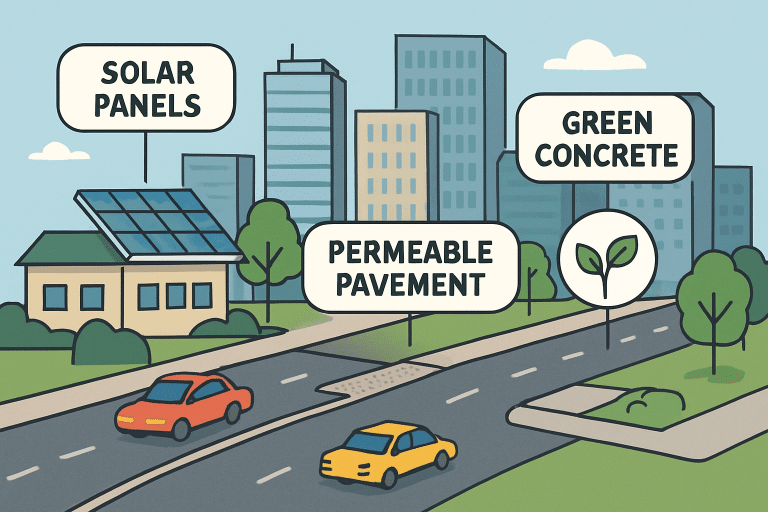Key Takeaways
- Emerging technologies are revolutionizing paving and concrete applications.
- Sustainable practices are at the forefront of modern construction methods.
- Innovations aim to improve durability, efficiency, and environmental impact.
Table of Contents
- 3D Concrete Printing
- Self-Healing Concrete
- Permeable Pavements
- Ultra-High Performance Concrete (UHPC)
- Green Concrete
- Fiber-Reinforced Concrete
- Solar Pavements
- Conclusion
Innovation is transforming every aspect of the construction industry, especially in the realms of paving and concrete technologies. Today’s advancements are not only increasing the strength and longevity of surfaces but also offering more sustainable ways to build. As cities and businesses strive to meet evolving demands, selecting a reliable commercial paving contractor has never been more crucial. These professionals are at the forefront of implementing modern materials and methods that define the future of our built environment.
Whether you are upgrading urban infrastructure, enhancing commercial properties, or developing new neighborhoods, staying informed about the latest advancements is essential. The rapid integration of new materials and innovative construction techniques is poised to reduce environmental impacts, lower costs, and enhance the functionality and aesthetics of roads, pathways, and hardscapes.
From printing concrete with robots to surfaces that generate electricity, technological breakthroughs are reshaping the possibilities for concrete and paving. As more urban centers explore green initiatives, climate resilience, and innovative energy solutions, modern paving technologies are responding with creativity and precision.
These innovative approaches don’t just promise efficiency and quality; they also prioritize longer life spans and reduced maintenance, aligning with the broader goals of smart, sustainable cities. With a strong focus on both productivity and planetary health, the construction sector is undergoing a genuine revolution.
3D Concrete Printing
One of the most exciting advancements in construction is 3D concrete printing. Utilizing automated printing equipment that extrudes custom-formulated concrete, this technology enables intricate designs and complex structural forms that traditional methods struggle to achieve. With possibilities ranging from residential homes to infrastructure elements, 3D printing drastically reduces labor, material waste, and construction timelines. As highlighted by ArchDaily, early projects have demonstrated not only structural integrity but also aesthetic freedom, making this technology a promising solution for urban growth and creative architecture.
Self-Healing Concrete
Self-healing concrete represents a leap forward for durability. By embedding tiny capsules of healing agents or specialized bacteria within the mixture, this innovative material can repair its own microcracks when exposed to moisture. This process, which may utilize bacteria that produce limestone or chemical fillers, prevents extensive deterioration and greatly extends a structure’s usable life. The adoption of self-healing concrete could revolutionize infrastructure maintenance, reducing repair costs and enhancing overall safety in high-traffic areas, bridges, and essential buildings. Its real-world impact is discussed in more detail by AP News.
Permeable Pavements
Permeable pavements are designed to let water pass directly through the surfacing material and base layers, making them a critical element in today’s sustainable urban design toolkit. These pavements help mitigate stormwater runoff, reduce the burden on drainage systems, and decrease urban flooding. They also play a pivotal role in replenishing natural aquifers while reducing heat buildup on city streets. Effective in commercial parking lots, sidewalks, and pedestrian zones, permeable pavements contribute to more resilient and environmentally conscious communities.
Ultra-High Performance Concrete (UHPC)
Ultra-High Performance Concrete is a high-strength material defined by its exceptional compressive and tensile properties. Capable of reaching strengths exceeding 20,000 psi, UHPC enables thinner yet more rigid constructions, making it an ideal choice for bridge decks, high-rise building cores, and critical infrastructure. Its dense composition ensures outstanding resistance to environmental wear, reducing the need for maintenance and supporting sustainable infrastructure investments. UHPC is increasingly used in innovative engineering projects worldwide, providing robust solutions where traditional materials fall short.
Green Concrete
Environmental sustainability is at the forefront of the latest concrete innovations, particularly in the realm of green concrete. This eco-friendly alternative utilizes recycled aggregates from demolished buildings, blast furnace slag, and fly ash, sharply reducing both the need for quarried materials and the carbon footprint of new construction. Modern green concrete technologies also harness carbon capture processes, sequestering CO2 as part of the mix and thereby supporting decarbonization efforts. As the demand for low-impact construction rises, green concrete ensures durability without compromising environmental goals.
Fiber-Reinforced Concrete
In applications where standard reinforcement isn’t feasible, fiber-reinforced concrete (FRC) offers a compelling alternative. By dispersing materials such as steel, glass, or synthetic fibers throughout the mix, FRC achieves enhanced tensile strength, reduced cracking, and improved impact resistance. This is particularly beneficial for pavements, industrial floors, and complex architectural features where flexibility and resilience are essential. Building on traditional strengths, fiber reinforcement enables the creation of durable, long-lasting structures—even in the most demanding conditions.
Solar Pavements
The integration of photovoltaic technology into pavement surfaces is one of the most forward-looking examples of innovation in construction. Solar pavements are engineered to convert sunlight into usable energy, powering nearby infrastructure such as street lighting or electric vehicle charging stations. Although still an emerging solution, the potential benefits include significant contributions to renewable energy generation, reduced utility costs, and enhanced smart city infrastructure. Early pilot projects demonstrate that as solar technology improves, its feasibility in public and commercial projects will continue to grow.
Conclusion
Recent developments in paving and concrete solutions are redefining what is possible in the built environment. From 3D printing and self-healing formulations to permeable and renewable-energy-generating surfaces, modern techniques deliver unmatched durability, efficiency, and sustainability. Staying at the forefront of these innovations ensures resilient, cost-effective, and environmentally responsible outcomes for commercial and urban projects—an imperative for any forward-thinking community or commercial paving contractor.
